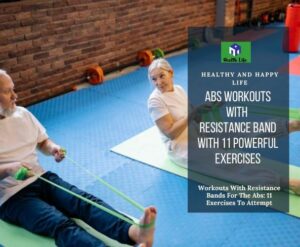When you hear someone talking about core strength, your mind usually immediately goes to their abdominal muscles. You may be concentrating your efforts, in particular, on the rectus abdominus (often known as the “six-pack muscle”). Continue reading to learn about what are the more effective resistance bands workout for abs development in your body.
Your rectus abdominus, which has muscle fibers that go in both directions, is responsible for flexing your spine. When you perform crunches, this motion is the primary mover.
However, your abdominals also include a deeper set of muscles under the rectus, such as your transverse abdominus, which has muscle fibers that run side to side and provides both postural stability and rotation, and your oblique muscles, which are your go-to muscles for side-bending and rotation. Your rectus abdominis is the most superficial of the abdominal muscles.
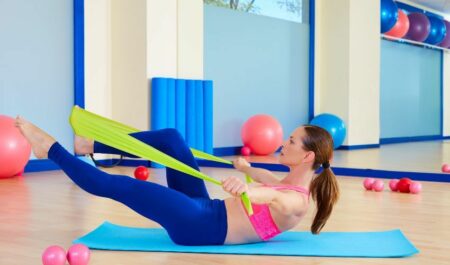
What Muscles Make Up The Core Of The Body?
Your hips and lower back muscles are also considered to be part of your core musculature. Keeping a healthy balance in your muscles is ideal for both function and posture.
A strong core requires consistent effort directed at developing both strength and stability throughout the body’s torso and abdominal region. When you have good posture, you stand higher, which is beneficial to both the appearance and the performance of your body.
How much of a challenge are you looking for? Endurance is more essential than raw strength when it comes to your abdominal muscles since they are always working to sustain the rest of your body. That is, it is more beneficial for you to perform a large number of repetitions with little or no resistance than it is to perform a small number of repetitions with a significant amount of weight.
Having said that, you may make improvements in both strength and endurance a little bit more effectively if you add a little bit of extra stress to your workouts. Because of this, resistance bands are a very useful tool.
You can get a good workout using resistance bands because they provide enough of a challenge to make your muscles work harder without requiring the same level of sheer power as hand weights or machines.
In addition, using resistance bands places a significant focus on stability as well as the eccentric contraction, which involves the stretching of muscles. This results in improved postural balance as well as more balance across the entire core.
How To Do Exercises With A Mini-Band?
Banded Bridge
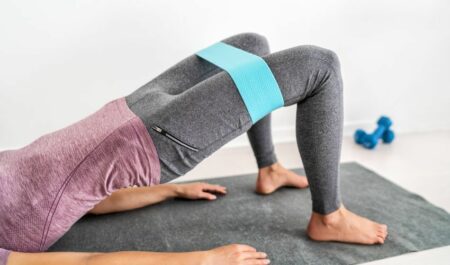
By applying pressure to the band, you may aid to engage your hip abductors, which are crucial stabilizers of the hip joint and the lower back.
Appropriate for both novices and advanced users.
- While lying faceup on the ground with a small band wrapped around your thighs, position your feet so that they are as near to your hips as is comfortable and roughly shoulder-distance apart.
- Raise your hips up while keeping your shoulder blades planted on the floor and maintain your knees wide while you bend them softly.
- Keep a large scoop in the belly as you roll the spine back down to the starting position.
- Perform two sets of ten repetitions.
Mermaid Twist
Your obliques will get a good workout from this move. As you rotate from the waist up, you should make it a goal to maintain your hips stationary so that you may reap the full benefits of the exercise.
Appropriate for: exercisers with some prior experience and above.
- Place yourself in a mermaid position by sitting out to the side on one hip and bending the knees of the person next to you. Establish a firm grasp on the tiny band with your lower hand.
- Maintain a long spine as you twist your body while holding the band close to your chest with the top hand. This will cause the band to stretch as you rotate your torso.
- Make sure that you maintain the effort focused in the middle of your body, rather than in your shoulders.
- Perform two sets of six to eight repetitions on each side.
Dead Bug With Bands.
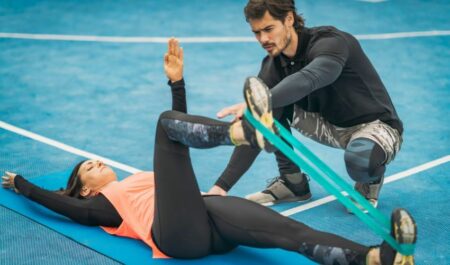
In order to strengthen the abdominal muscles, it is important to avoid arching the back and instead maintain a neutral, stable position for the spine throughout the action.
Appropriate for: exercisers with some prior experience and above.
- The small band should be looped around one foot, and the other hand should be used to hold it.
- Maintain stability in the shoulder and hand on the banded hand while extending the leg that is being banded.
- If you want to add more intensity to the move, you can reach the hand that is not banded up toward the ceiling.
- Pull your belly button in toward your spine to stabilize it as you stretch and manage your return to the starting position.
- Carry out two sets of ten repetitions on each side.
Banded Plank Walk.
Instead of overworking your hip flexors, which can cause your lower back to arch, concentrate on bringing your leg forward while engaging your abdominals for control. This will allow you to get the most out of this exercise.
Appropriate for: more experienced athletes.
- Assume a plank posture on your hands or elbows and wrap a band around your thighs, positioning it so that it is just above your knees.
- Move your legs forward into a bear plank posture, with your knees hovering just above the floor, and then walk them back into a straight-legged plank position while maintaining core stability.
- Be careful to contract the abdominals and switch whatever leg you’re leading with so that you achieve symmetry.
- Perform two sets of eight repetitions, switching the lead leg between sets.
Mountain Climbers.
When trying to improve your speed, be careful not to compromise your form.
Appropriate for: more experienced athletes.
- Find your way into a plank position with your arms in a straight line and your feet hip-distance apart as the band is wrapped around the arches of both feet.
- Pulling one knee nearer your elbows will stretch the small band and engage your core. Alternate legs as you perform this movement.
- Perform two sets of 15–20 complete repetitions in each.
Following Moves With A Flat Band Workouts
Rollup That Is Under Control.
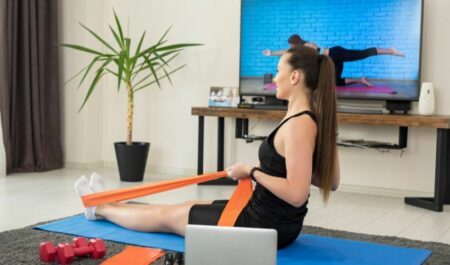
In this particular scenario, the band will be of assistance to you during the upward portion of the action. On the way up, it does a reverse curl for you, helping to develop your back and abdominal muscles while making the upward motion easier.
Appropriate for both novices and advanced users.
- Take a seat on the ground and loop a resistance band over each of your feet, being sure to keep both hands on the band.
- When you are in a supine posture, slowly roll your spine down to the floor while scooping your abdominals in into your spine.
- Make a little nod with your chin, and carefully roll over onto your back to return to a sitting posture. Maintain as much of a straight arm position as you can so that the work is not transferred to the biceps.
- Perform one set of eight to ten repetitions.
Russian twist.
While was indicated before, you will get the most out of rotation exercises for your obliques if you concentrate on stabilizing your hips and working your way up from the waist as you rotate. It is important to remember to maintain your spine long and to avoid compressing the lumbar spine in order to protect the lower back.
Appropriate for both novices and advanced users.
- Assume a V-sit position on the floor, with your knees bent and your heels resting on the ground.
- Wrap the band over both of your feet, and then grasp the ends of the band in both of your hands.
- Maintain control of your lower body while twisting the rib cage and moving your hands quickly from hip to hip. This motion should be done with a lively speed. On the other side, repeat the process.
- You may increase the difficulty of this maneuver by lifting your feet off the ground, and you can increase the difficulty even more by extending your legs.
- Perform two sets of 15 complete repetitions for each set.
Banded Bird Dog.
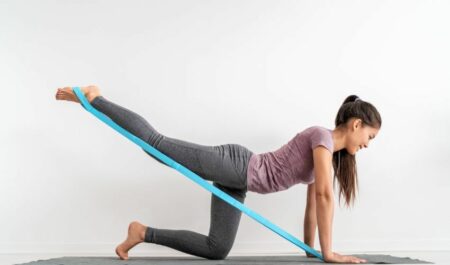
When performing this exercise, you should concentrate on activating the muscles in your hamstrings and shoulders to move the band while maintaining your core engaged. Your lower back can easily arch, so you should make it a priority to preserve your spine long and powerful.
Appropriate for: exercisers with some prior experience and above.
- While on your hands and knees, wrap one end of the band over the arch of one foot and grasp the other end of the band in the hand on the opposite side.
- Extend the banded arm while also extending the banded knee at the same time.
- Maintain a stable spine by using your abdominal muscles, and strive for smooth movement.
- Carry out two sets of ten repetitions on each side.
Banded Wood Chop
Before you start tugging the band with your hands, you should give it your best effort to rotate from the torso first.
Appropriate for: exercisers with some prior experience and above.
- Take a split stance, with one foot in front of the other to anchor one end of the band.
- The opposite end of the band is held firmly in both hands.
- You should rotate toward the direction of the rear leg while simultaneously elevating your arms to stretch the band while maintaining a strong core and stable hips.
- Carry out two sets of ten repetitions on each side.
Palov press.
The Palov press challenges your abdominal muscles in their role as stabilizers throughout the body. Therefore, in this situation, you want to keep your torso as still as possible as the resistance pulls on your body.
Appropriate for: exercisers with some prior experience and above.
- Set the anchor at the level of the shoulders and rotate to the side by ninety degrees.
- Extend your arms and move away from the anchor until you feel a sufficient level of tension, and then bring the elbows back in toward your chest. This motion should be repeated until the desired amount of tension is achieved.
- Extend your elbows in a slow and controlled manner while keeping the tension in the band throughout the exercise.
- While you are pressing your arms out in front of you, try not to twist your body. Returning to the beginning posture requires you to bend your elbows.
- Perform two sets of ten repetitions. Make sure that both sides are completed.
Dual Stretches For The Legs

Throughout the action, you should strive to keep your bottom rib linked to the floor and keep your spine in a neutral position.
Appropriate for: more experienced athletes.
- Lay on your back and raise your feet off the ground so that your legs are in a tabletop posture. Your hips and knees should be bent at a right angle of 90 degrees.
- The centre of the band should be wrapped around your feet, and the ends should be anchored in your hands.
- While you bring your abs down toward the floor, stretch both legs out away from your torso and manage how they return to their starting position. You may increase the difficulty of this exercise by extending your arms above and lifting your head and shoulders off the floor. This will make the workout more difficult.
- Perform one set of 12–15 repetitions.
Advice On How To Avoid Injury When Working Out Your Abs Using Resistance Bands.
Before each activity, it is essential to give the band a thorough inspection to look for any little tears. Because elastic might break, it is important to take precautions to avoid having a broken band strike you in the face. If you see any tears or nicks in your band, you shouldn’t take any chances and should instead replace it.
Form is of the utmost significance while dealing with ever more difficult resistance.
You are more likely to move in a controlled manner when you are in the muscular contraction (concentric) phase, but when you are in the muscle lengthening (eccentric) phase, it is simple to disregard that control and move in an uncontrolled manner. However, doing so might cause harm to both the muscle and the connective tissue in the body.
Both an improvement in strength and a decrease in the likelihood of damage can result from ensuring a gradual release of tension.
The Bottom Line
Workouts using resistance bands are convenient equipment that can be done at any time and in any location.
They are small and simple to transport, they have the ability to deliver an adequate amount of resistance to build both strength and endurance, and they deliver an adequate amount of diversity to keep the exercises interesting. It has never been simpler to improve both your core strength and your posture.
